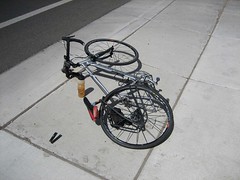 Keith Bradsher wrote in yesterday’s New York Times about what happens when we start using food for fuel:
Keith Bradsher wrote in yesterday’s New York Times about what happens when we start using food for fuel:
In some poor countries, desperation is taking hold. Just in the last week, protests have erupted in Pakistan over wheat shortages, and in Indonesia over soybean shortages. Egypt has banned rice exports to keep food at home, and China has put price controls on cooking oil, grain, meat, milk and eggs.
According to the F.A.O., food riots have erupted in recent months in Guinea, Mauritania, Mexico, Morocco, Senegal, Uzbekistan and Yemen.
“The urban poor, the rural landless and small and marginal farmers stand to lose,” said He Changchui, the agency’s chief representative for Asia and the Pacific.
A startling change is unfolding in the world’s food markets. Soaring fuel prices have altered the equation for growing food and transporting it across the globe. Huge demand for biofuels has created tension between using land to produce fuel and using it for food.
Further reading:
- Cashing in on palm oil for conservation, from Nature, a piece on the complex politics and economics surrounding the palm oil explostion
- The end of cheap food, from The Economist



 I woke up Sunday morning for the first time in year without thinking about what work I needed to do that day on the book. The manuscript sits in a stack on the shelf next to me. (They want it printed on paper in addition to being burned onto a CD! How quaint!)
I woke up Sunday morning for the first time in year without thinking about what work I needed to do that day on the book. The manuscript sits in a stack on the shelf next to me. (They want it printed on paper in addition to being burned onto a CD! How quaint!) On the
On the  From the
From the  Died in a haberdashery accident.
Died in a haberdashery accident. I’ve always been fascinated by astronomy’s variable sky community – the folks who look for things that change.
I’ve always been fascinated by astronomy’s variable sky community – the folks who look for things that change.